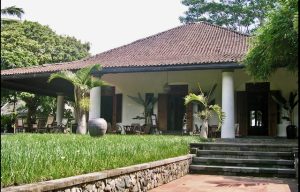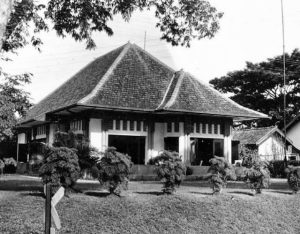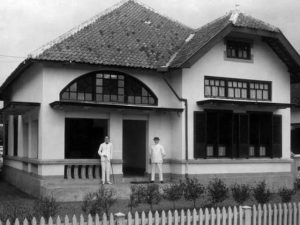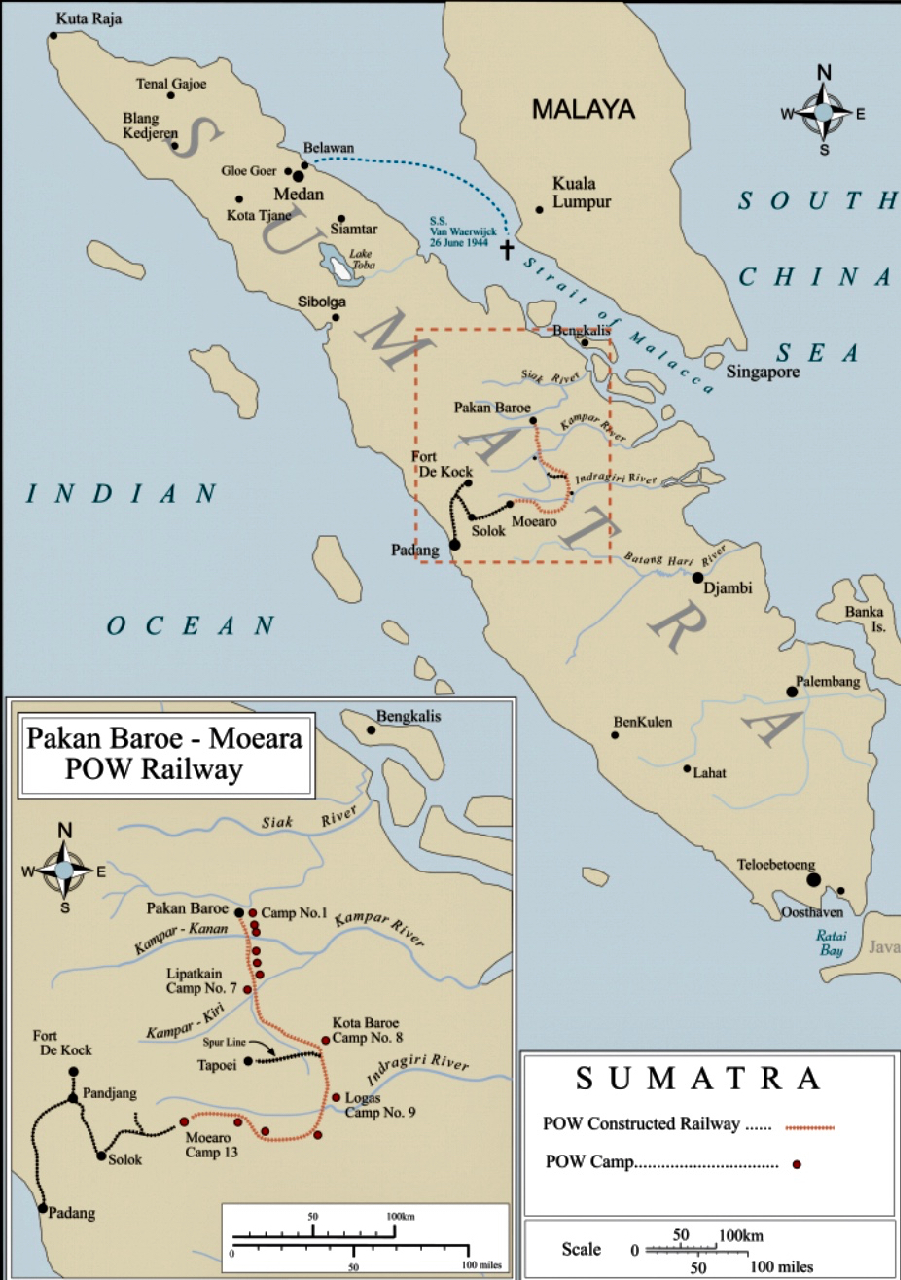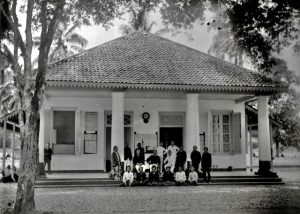
CAPTURE OF SUMATRA
The Japanese capture of Sumatra took place in two stages: South Sumatra was taken mid-February 1942, North & Central Sumatra followed in March.
South Sumatra’s oil installations at Palembang were an important target for the Japanese.
14 February 1942 about 600 Japanese parachutists landed near one of two airfields at Palembang and at the city’s two refineries. A Javanese KNIL company drove the Japanese away from one refinery but the other installation was only partially recovered. It soon became clear a large number of Japanese infantryman were arriving via Musi River. The local KNIL commander was ordered to withdraw and destroy oil installations. The destruction was partially successful. Most KNIL, British and Australian troops in South Sumatra escaped to Java, together with some European women and children.
The Japanese troops march northwards. On 11 and 12 March 1942 Japan’s 25th Army landed at four locations on the east coast of North and Central Sumatra: Sabang, Kutaradje, Idi and about 100 km southeast of Medan.
The 25th Army had received support from the natives, especially in Atjeh, where anti-Dutch sabotage operations were carried out even before the arrival of the Japanese. Atjeh had been in a civil war with the Dutch in late 1800’s. Relations continued to be strained. The Dutch treated many locals as slave labour.
The KNIL detachments were forced to evacuate coastal areas, withdrawing in groups towards the interior of North Sumatra with intentions of setting up guerrilla forces in the mountains. Nothing came of this plan. Troop numbers were decimated by desertion, plagued by Atjeh rebels or overtaken by advancing Japanese. Most units never reached the mountains. The remaining KNIL troops of North and Central Sumatra surrendered at Blangkedjeren on 28 March 1942. Dutch Major General R. T. Overakker, Middle Sumatra Territorial Commander with 2,000 soldiers surrendered near the town of Kutatjane in North Sumatra. Many of these prisoners were forced by the Japanese to work on the construction of the railway – Pekanbaru to Muaro.
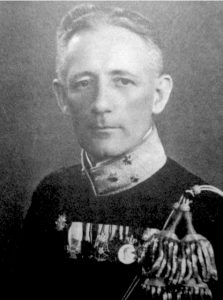
Though the senior Dutch officer on Sumatra, Overraker did not receive command of all Dutch forces on Sumatra until the defense of Java was on the verge of collapse. He attempted to hold out in the mountains of northern Sumatra but was finally forced to surrender on 28 March 1942.
Overakker, and other KNIL, (The Royal Netherlands East Indies Army) officers in captivity were shot/executed in August 1945 at Fort de kock in view of the impending defeat of Japan! The Japanese simply did not want them liberated by the Allies. They were returned to Sumatra from their Korean POW Camp to face Japanese Court charges (that means they were not allowed a lawyer and very likely the court proceedings were in Japanese language only.
Overraker was interrogated in Medan and Fort de Kock because the Japanese suspected him of having been one of the initiators of a resistance organization on the east coast of Sumatra. Overakker’s written order was found, sealing his fate and the lives of several of his top men.
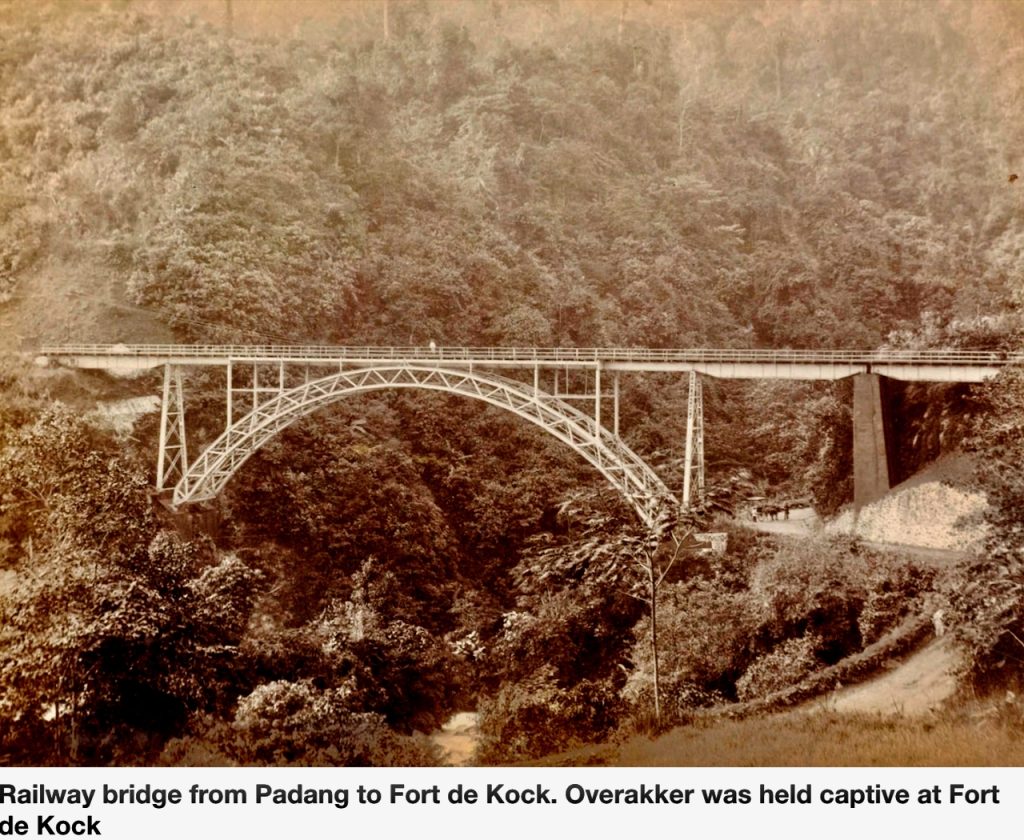
Below: Fort de Kock

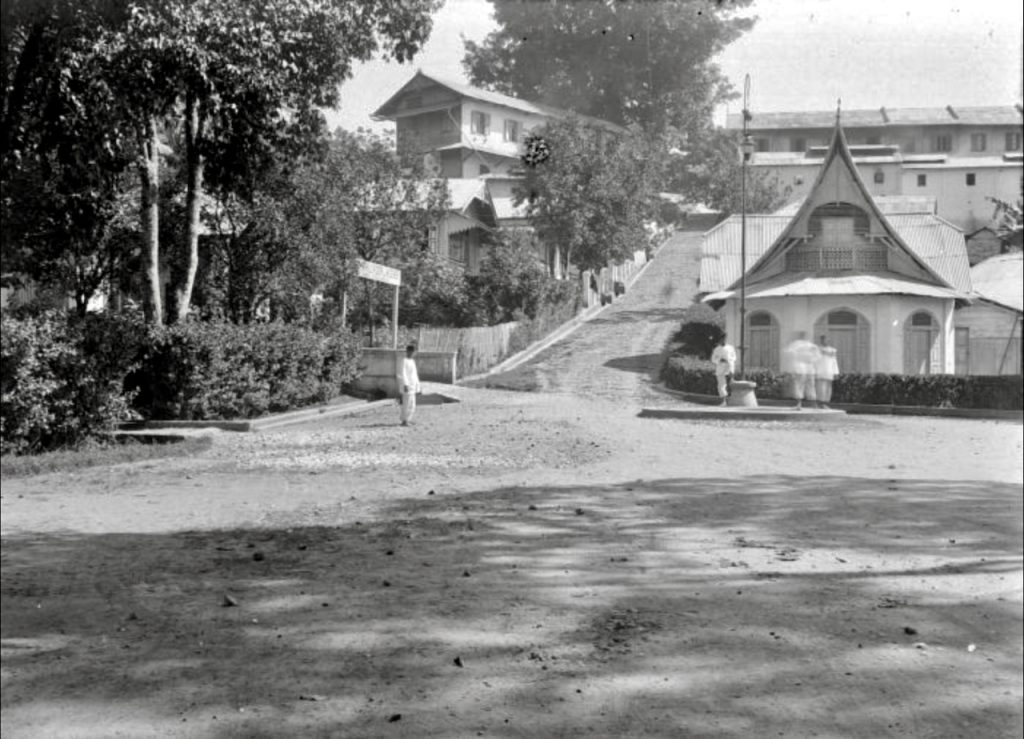
POWs in Sumatra were largely concentrated in camps near Medan and Palembang. Large numbers were shipped overseas including to Burma-Thai Railway, Burma and included POWs such as Dr. Albert Coates whose presence on the railway hospitals was so important to Australians of ‘A’ Force working on the Railway.
During 1943 and 1944 thousands of POWs were shipped from Java to Sumatra to be put to work there. In August 1945 there were POW camps along the Pakanbaru railway and in and around Palembang.
Civilian internees of North, Central, and South Sumatra stayed in their own regions throughout the war. In 1945 (when the tide was turning against Japan) all civilians were moved to larger assembly camps in central and interior Sumatra. There was a separate camp for men and another for women with children. But these camps were not so far apart.
Eight (8) 2/4th who managed to escape Singapore Island, taken POWs of Japan at Sumatra, then part of Netherlands East Indies:
Richard Annear, Burgess, Ted Hopson, Arthur Magill, Quinn, Semple, Harold Smith and Squance
Ted Hopson died 26 April 1944, buried 200 yards south of 28 kilo peg on Blangkejeren-Tekencong Road.
Following sinking of POW Transport Ship SS Harujkiku 1944, Burgess, Semple & Harold Smith remained Singapore with injuries or illness.
Richard Annear, Arthur Magill, Quinn & Squance returned to Sumatra Railway with Java POWs Banks, Booth & McAskil
These three 2/4th men were sent to Java and not Singapore
(Booth & McAskil died of illness on Railway 1945)
FIVE (5) 2/4TH MEN WERE RECOVERED FROM RAILWAY AT END OF WAR.
Please read more details about the ‘Harugiku’ sinking
March 1944 – 11 October 1944
Construction of roads to Atjeh
Sumatra
‘In Central Aceh, a road had to be built between Takengon and Blangkedjerèn in order to provide the Japanese army with a connection between North and Central Sumatra, but through the interior, in addition to the existing coastal road along the east coast. This road connected in the north with the existing road from Bireuën to Takengon, and in the south with the road from Blang Kedjerèn towards Lake Toba.
Blangkedjerèn was the base camp, from which the camps along the road were supplied. The camps along the road were named according to the distance in kilometers from Blangkedjerèn: camp 9, camp 13, camp 23, camp 29, camp 38 (at an altitude of over 2000 m).
Construction started on 01-1-1944 with romushas. On 16-03-1944 the prisoners of war started. The road was ready on 20-07-1944.’
When the 50 Australian POWs selected with Atjeh Party departed Gloe Gloer camp, Sumatra on 8 March 1944 – 49 Australians were left amongst the remaining group of POWs – including Roy Semple, ‘Win’ Annear, ‘Squasher’ Squance, Alf Burgess and Harold Smith from 2/4th.
The fifty Australians in the Atjeh Party were under the command of Lt Tranter of 2/29th Battalion. The entire Atjeh Road Party was 500 POWs. 275 Dutch and the remainder British. 2/4th POWs included Ted Hopson, George Quinn and Arthur Magill.
On the first day, 8th March 1944 they travelled about 308 kilometres to Kota Tjane – located about 10 kilometres north of Laubaleng, in the heartland of Sumatra. The POWs were billeted in a schoolhouse for two days and then loaded again onto trucks. Surprise can hardly be the word the POWs felt when the trucks turned around and headed back to where they had just left.
The following day on 13 March 1944, the group were back on the road again this time on a 145-kilometre march to an undisclosed destination.
The first night was spent at Gunung, the second at Maloek. On 17 March after four day’s marching, the men arrived at their destination, Blang Kedjeren. They were accommodated in a former Dutch Army barracks known to the POWs as the Hospital Camp.
The sick and those unable to march any further were left here, some never to be seen again.
The next day the men were back on the road marching until they reached their camp at Tenal Gajoe – this was the territory of Atjeh or Achinise natives. Renowned as fierce head-hunters, these people had never been completely subdued during the Dutch colonisation of Sumatra. There had been a war between the locals and the Archinise.
In the late 1700’s Dutch planters had moved into this rich area of north Sumatra. Initially the Dutch planters grew tobacco. However it is well known the planters used the local population as ‘slave’ labour.
There were two camps. One for British and Australians and the second one for Dutch. They remained here about 3 weeks as the road they were building progressed north and on 3 May 1944 POWs moved to Kedjeren.
Ted Hopson was left at Tenal Gajoe suffering with appendicitis. Because he was also ill with dysentery it was not possible to perform an operation for fear of infection. Ted died on 26 April 1944 aged 35 years.
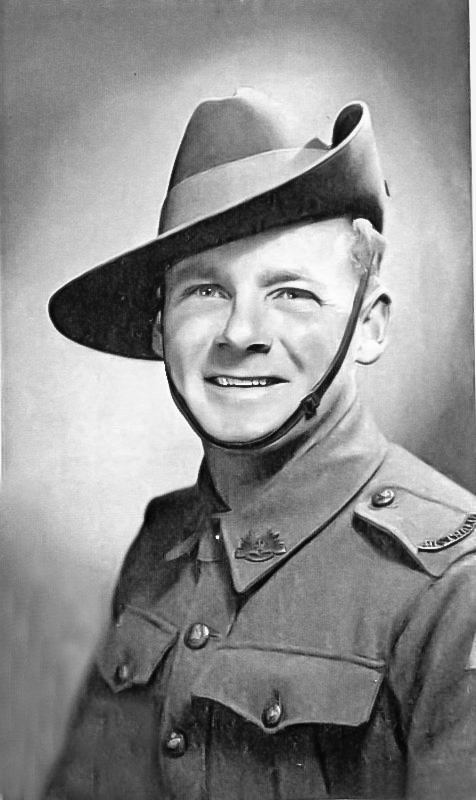
Ted was popular and well liked amongst the group. He was described as being ‘a good bloke’. His body was brought to Blang Kedjeren where a coffin was constructed. This popular machine gunner was laid to rest about 100 yards from camp. Amongst the POWs was a stonemason who cut a headstone, which was placed at the head of Ted’s grave.
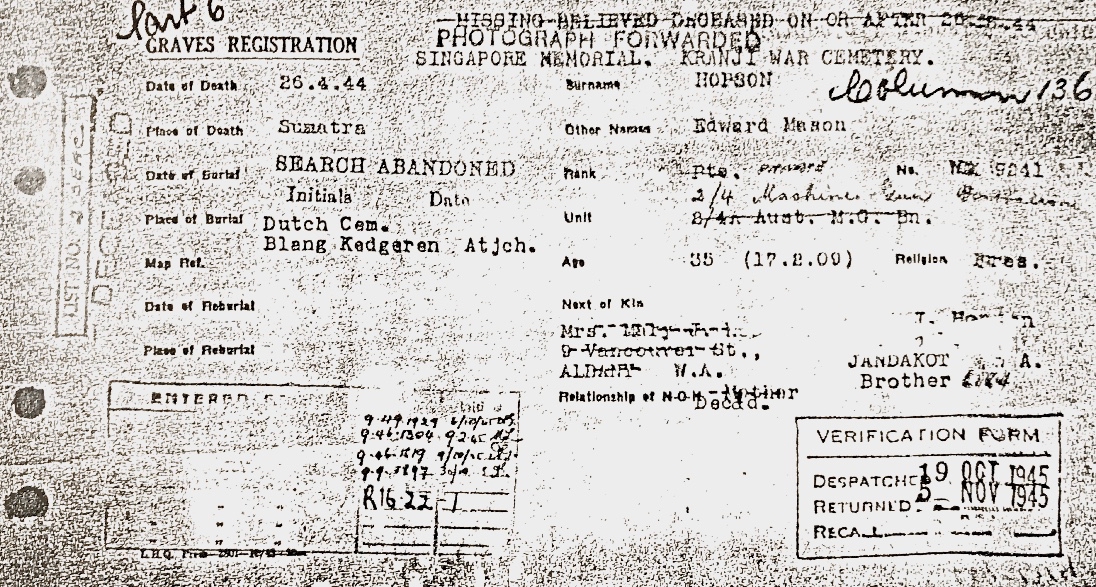
Above: July 2020 we are surprised to learn Ted Hopson’s grave and several other POWs was never found by War Graves Party, and the Search abandoned.
The road construction continued to the east in between their current camp and previous camp at Tenal Gajoe. By 6 October 1944 it was time for POWs to head back to Medan. They set out in three columns as they had done on their journey north. As the columns passed Ted’s grave they all paid their friend a respectful ‘eyes left’.
Please read the poem written for Ted
The group arrived back at a rest camp on the outskirts of Medan on 11 October 1944 five days after setting out from Blang Kedjeren. After a week’s rest on reduced rations the POWs were given the news that they were again on the move. They marched 3 miles to the railway station and following a short journey; they were detrained and loaded onto trucks.
Using the same route as they had travelled on the way to Medan, they headed back towards Fort de Kock on the west coast of Sumatra. The POWs were billeted 3 days in the old Police Barracks at Bukit Tinggi after which they were loaded back on the train for a lengthy journey to Mocearo, arriving 21 October 1944.
It was here that the POWs were informed they were to build a 3’ 6” gauge railway line between Pakan Baroe and Mocaero. A distance of 220 kilometres.
In addition to this main line there was a shorter 2’ 5 ½ “ narrow gauge 20 kilometre spur line which branched off the main line at 119 km point!
Below: Cecil Quinn who survived to return home to Western Australia.
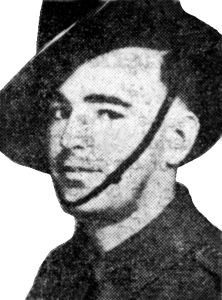
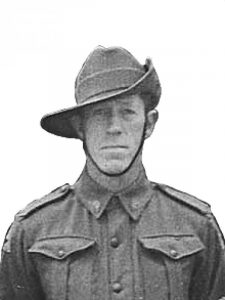
Right: Robert McAskil who had sailed from Java- Singapore- Sumatra with Harold Booth and Noel Banks, died illness Kampoeng, 106km Camp, near Kota Baroe, Sumatra 23 March 1945 aged 44 years.
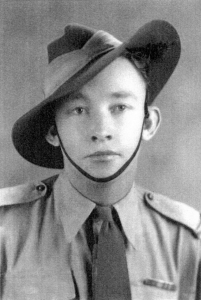 Left: Arthur Magill.
Left: Arthur Magill.
Please read further for more about Pakan Maroe Railway
Also read about 2/4th boys who escaped Singapore, arriving Sumatra
Below: Survivor – Annear (his brother died attempting escape from Singapore Feb 1942)
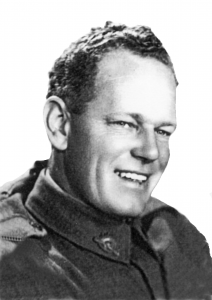
Right: Squance 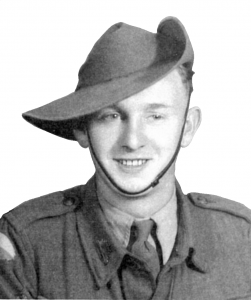
Please read about the POWs being evacuated from Sumatra to Singapore at end of war.
You can read list of men who were imprisoned at GloeGoer Camp
Below: Melbourne Cup Frog Race 1942 – won by 2/4th’s ‘Bluey’ Semple
‘One Sunday, the nearest to Melbourne Cup Day, the Australians decided to run their own cup. Frogs were the contestants. A West Australian, Bluey Semple (WX7532) appeared in jockey’s colours with a riding whip. Nobody knew where they came from. Appropriately his frog won, and he was presented with the cup – half a coconut on a stand.’
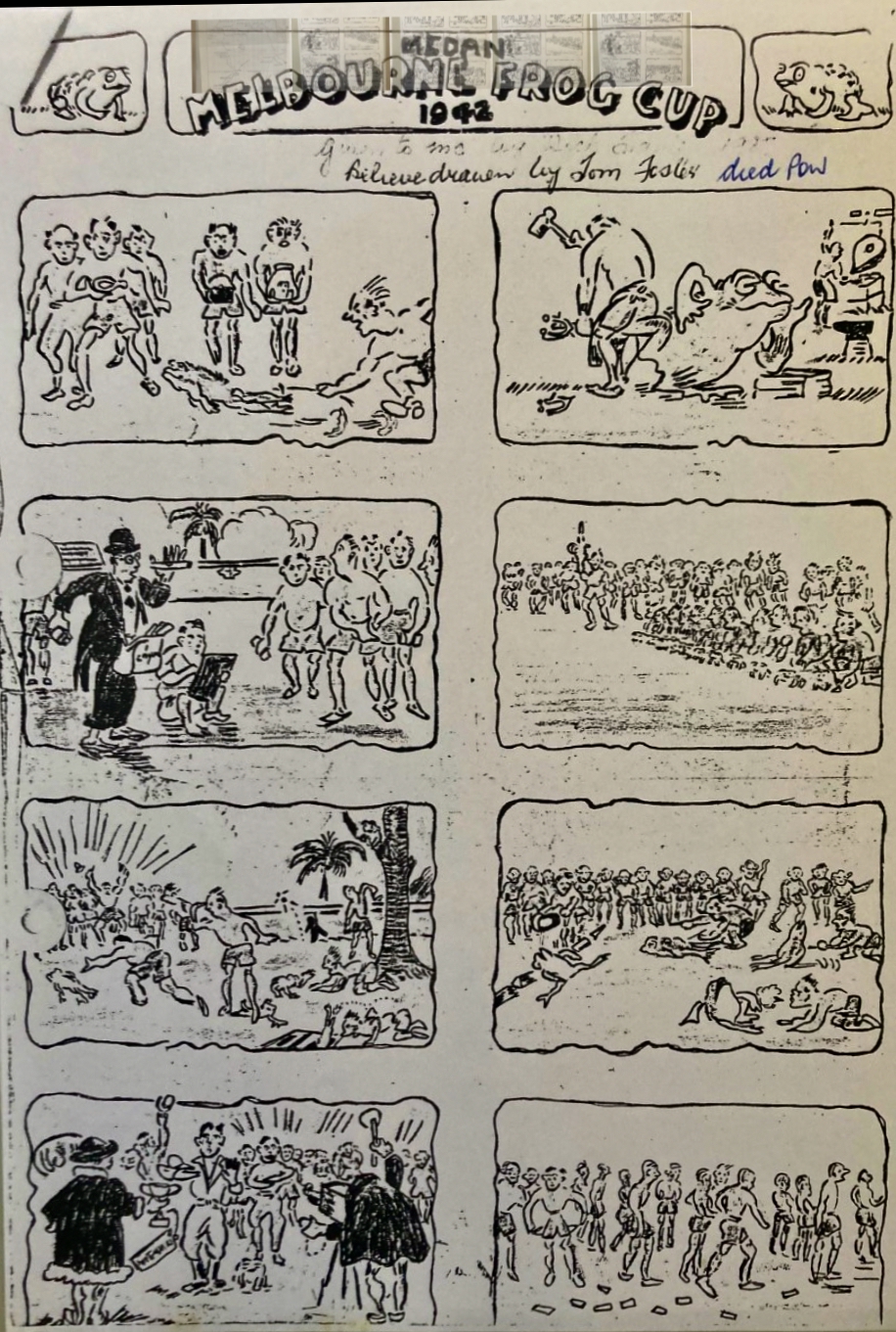
Aside from the POWs who died, an unknown, but large number of Javanese labourers were brought to slave on the railway. Their deaths were terrible and barely counted.
Remember many European/civilian families were imprisoned at Sumatra.
By the end of the war a total 163 European women and children along with 136 men and boys had died at the camps in Bangkinang.
‘Harugiku’ Maru – SS Van Waerwjick Party
When the 50 Australian POWs selected to work in the north of Sumatra, Atjeh Party departed Gloe Gloer camp, Sumatra on 8 March 1944 – 49 Australians were left amongst the remaining group of POWs – including Roy Semple, ‘Win’ Annear, ‘Squasher’ Squance, Alf Burgess and Harold Smith from 2/4th.
On 24 June they were alerted to be ready to leave for Singapore and the following day trucks arrived at Gloe Gloer camp to transport the POWs to the port of Belawan to board the ship taking them to Singapore.
The ship was SS Van Waerwjick, a 3,040-ton passenger-cargo ship captured by the Japanese on 3 March 1942. As was the Japanese custom the ship was renamed ‘Harugiku’ Maru
The POWs arrived at the docks around noon at Medan and were crammed into the fore and aft hold of the ship. A Japanese corvette was to act as escort to this small convoy that included 2 tankers and 2 transport ships. The ‘Harugiku’ Maru left Belawan about 1500 hours on 25 June, heading into the Malacca Straits to join the convoy.
The following day, 26 June at 1350 hours two mighty explosions amidships rocked the ship which broke into two and sunk within minutes. Two torpedoes had been fired from HMS Trucelent which was depth charged, causing ‘Harugiku’ Maru to hit the bottom at 68 feet. There was no loss of life from the 2/4th but tragically 167 POWs went down with the ship.
Below: HMS Trucelent


Following four hours of treading water, the men were rescued by one of Japanese tankers from the convoy. The POWs then continued their voyage on board this tanker to Singapore where they disembarked and were taken to River Valley Road Transit Camp. 2/4th men Annear, Squance, Magill, Quinn would return to Sumatra to work on the Pakan Baroe-Moearo railway.
Harold Smith was hospitalised with appendicitis on 21 July and Alf Burgess suffered a head injury from the Harukiku Maru sinking. Semple also remained in Singapore, obviously ill.
At the end of the war they were all recovered from Changi Gaol.
In hindsight Smith, Burgess and Semple were extremely fortunate to avoid working on the construction of Railway in Sumatra.
Below: Prior to the march to Atjeh, the medical officers wrote the following letter Lt. Miura.
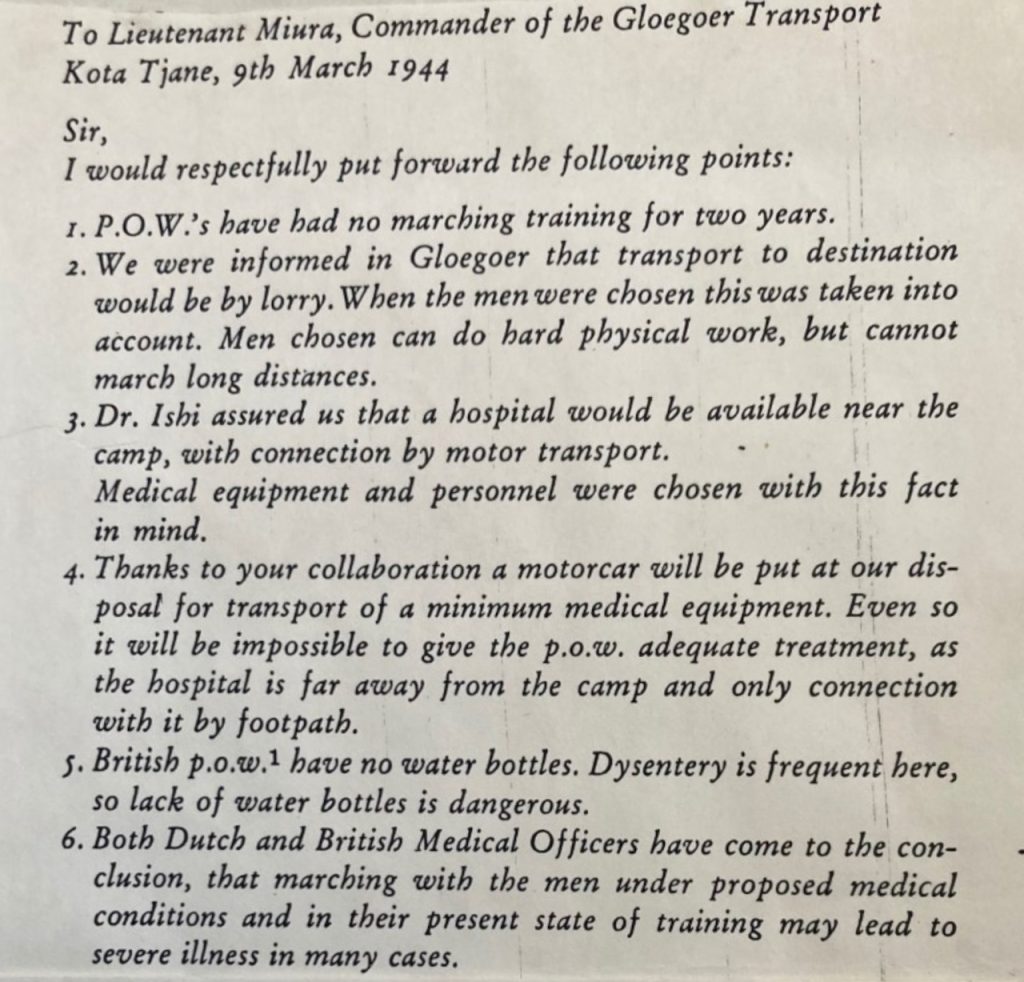
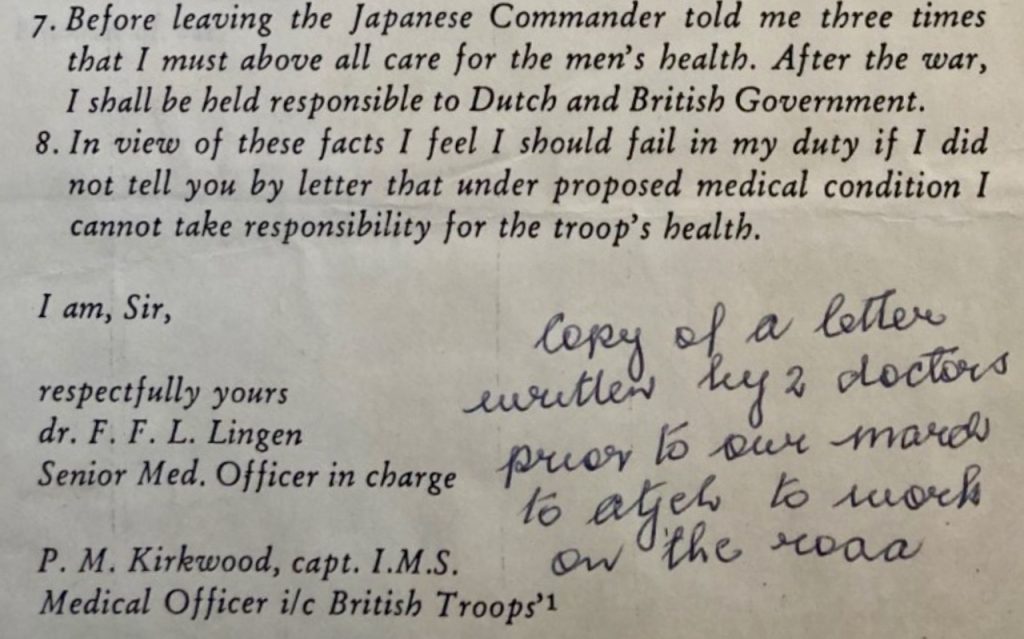
Sumatra 2004
On 26th December 2004 without warning one of the world`s deadliest tsunamis hit the north-western coastline of the Sumatra. A 9.3 earthquake with more than 30 metres high monster-waves smashed the pristine shores of Aceh leaving at least 230,000 people dead. The western shores of Banda Aceh were completely destroyed.




